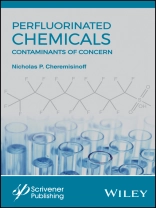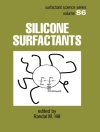This new volume provides a timely study on the environmental challenges from a specific class of perfluorinated chemical compounds (PFCs) that are now being recognized as a worldwide health threat. Recent studies report that levels of classes of PFCs known as polyfluoroalkyl and perfluoroalkyl (PFASs) exceed federally recommended safety levels in public drinking-water supplies for 6 million people in the United States and that as many as 100 million people could be at risk from exposure to these chemicals.
These chemicals occur globally in wildlife and humans. Both PFCAs and PFSAs have been produced for more than 50 years, but have only become of interest to regulators and environmentalists since the late 1990s. Recent advances in analytical methodology has enabled widespread detection in the environment and humans at trace levels. These toxic chemicals have been found in outdoor and indoor air, surface and drinking water, house dust, animal tissue, human blood serum, and human breast milk. Of great concern to communities is the presence of these compounds in a number of drinking water supplies in the U.S. and other countries.
This new volume provides a timely explanation of the chemicals, provides a detailed review of the regulations both in the US and European Community, explains the health risk literature, and then explores in great detail available treatment technologies. The volume is a must for public water supply facilities, industrial operations that have historically used these chemicals and face legacy pollution issues, policy makers and the general public.
สารบัญ
Preface ix
About the Author xv
Abbreviations and Acronyms xvii
Useful Conversion Factors xxi
1 What Fluoropolymers Are 1
1.1 Introduction 1
1.2 Evolution of Fluoropolymers and the Markets 3
1.3 PFAS Compounds 6
1.3.1 General Description 6
1.3.2 How They Are Made 10
1.3.3 The Proliferation of PFAS 15
1.4 Terminology 17
References 19
2 Definitions, Uses, and Evolution of PFCs 21
2.1 Perfluorinated Chemicals (PFCs) Of Interest 21
2.2 The PFC Family 43
2.3 PFOS 44
2.4 PFOA 49
2.5 Fluorotelomers 50
References 52
3 Fire Fighting Foams 55
3.1 What AFFFs Are 55
3.2 Environmental Impacts 58
References 62
4 Health Risk Studies 63
4.1 General 63
4.2 PFOA 65
4.3 PFOS 77
4.4 EFSA – EU Food and Safety Authority Findings 77
References 90
5 Overview of the Environmental Concerns 91
5.1 Where It All Began 91
5.2 Emerging Contaminants of Concern 93
5.3 PFOS 96
5.4 PFOA 100
References 107
6 The Supply Chain and Pathways to Contamination 109
6.1 Losses Along the Supply Chain and End of Life 109
6.2 Consumer Articles 119
6.3 Consumer Exposure to PFOS and PFOA 124
References 127
7 Standards, Advisories, and Restrictions 129
7.1 Extent of Groundwater Contamination in the United States 129
7.2 The U.S. Water Quality Standards 133
7.3 Remedial Guidelines 142
7.4 Standards in Other Countries 143
7.4.1 United Kingdom 144
7.4.2 Canada 144
7.4.3 Germany 145
7.4.4 Norway 145
7.4.5 European Union (EU) 146
7.4.6 OECD 148
7.4.7 Stockholm Convention on Persistent Organic Pollutants (POPs) 149
7.4.8 United Nation’s Economic Commission for Europe (ECE) 150
References 151
8 Overview of Water Treatment Technology Options 153
8.1 Technology Options 153
8.2 Case Studies, Literature, and Technologies 156
Reference 163
9 Adsorption Technology 165
9.1 Overview 165
9.2 Activated Carbon and Other Carbonaceous Adsorbents 169
9.3 Zeolites 178
9.4 Polymeric Adsorbents 179
9.5 Oxidic Adsorbents 180
9.6 Adsorption Theory Basics and Isotherms 181
9.7 Adsorption of PFOA 186
9.8 Hardware and Operational Considerations 189
9.9 Backwashing 196
9.10 Permitting 197
9.11 Spent Carbon Management 197
9.12 Recommended References 198
References 201
10 Case Studies 203
10.1 PFOA in Southern New Hampshire 203
10.2 Former Wurtsmith Air Force Base 206
10.3 Dupont Washington Works in West Virginia 213
10.4 PFC Contamination in Minnesota 218
References 228
Index 229
เกี่ยวกับผู้แต่ง
Nicholas P. Cheremisinoff is the Principal of No Pollution Enterprises. He is a chemical engineer specializing in the safe handling and management of industrial chemicals and hazardous materials with nearly forty years of industry, business and applied research experience. He earned his B.Sc., M.Sc. and Ph.D. in chemical engineering from Clarkson College of Technology in Potsdam, New York. Over his long career he has worked pollution prevention and waste to energy projects in the refining, gas processing and the petrochemicals industries for numerous U.S. and foreign clients. For international lending institutions including the World Bank Organization, the U.S. Export-Import Bank, the International Finance Corporation, and donor agencies including the U.S. Agency for International Development, the U.S. Trade & Development Agency, and the European Union he has served as consultant and technical advisor on pollution management, worker safety, and environmental management practices. He has also held academic positions, including adjunct professor at the New Jersey Institute of Technology and Farleigh Dickenson University, and has been an invited Lecturer at the Russian and Ukrainian Academies of Sciences, the Jordan University of Science and Technology, Texas A&M University, University of Missouri-Rolla, Cooper Union University, and the University of Leuven. He has authored, co-authored or edited more than 100 technical reference and textbooks.












